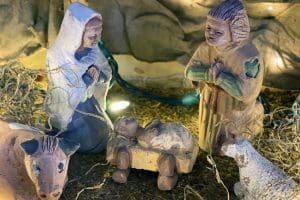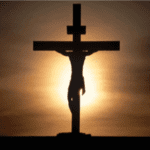Moses 1:27-Moses 3
In Doctrine and Covenants 52:14, God declares that he will “give unto you a pattern in all things, that ye may not be deceived.” Moses chapters 1 through 3 establish God’s patterns and laws of creation. Thereafter, anything to be created need only reenact those events of the first or primordial creation.
This lesson will focus on the pattern of creation and conclude with the purpose for any creation, not just the “in the beginning” creation. I believe that understanding the “hows” and “whys” of the “in the beginning” events is more significant than just knowing “what” was created. It is by understanding this primordial pattern that we can begin to apply the pattern to ourselves.
How the Elements are Created
The creation account of Genesis and Moses reveal the fundamental principles upon which all creation occurs. These are as follows:
1.Water and Darkness: In the primordial creation of the heavens and earth, we first discover that the earth was “without form, and void.” In other words, it was in a state of chaos. This chaos is characterized by “darkness” being upon the “face of the deep” (Moses 2:2). The state of being enveloped by water and darkness becomes symbolic of the state of an object prior to being created. Thus, anything that is to be created, born or reborn must begin in the state of chaos, characterized by being surrounded in water/darkness.
2.Spirit of God: The creation commences as the “Spirit of God” begins to move upon the face of the water. Doctrine and Covenants 84:45 states that the “word of the Lord is truth… and truth is light… and light is Spirit, even the Spirit of Jesus Christ.” Thus when the apostle John declares that in the beginning was the word; he is speaking of the Spirit of Jesus Christ, “which truth shineth. This is the light of Christ” (Doctrine and Covenants 88:7). Now, this light of Christ (or as called in Moses 2, the Spirit of God’) is “the light of the sun, and the power thereof by which it was made…” it is the “light which is in all things… even the power of God.” (Doctrines and Covenants 88:7-14, italicized for emphasis). Once in a state of chaos, God’s power, the light, acts upon the elements to bring forth creation.
3.The Word: As the creation continues, we see God utilizing the medium of the word to act upon the elements. It reads “And God said… And God called… And God said… And God called.” The pattern is obvious God says and then he calls (or gives it a name). The word is the medium of God’s power – it is the manner in which the power is exercised. Joseph Smith stated, “We ask, then, what are we to understand by a man’s working by faith? We answer – we understand that when a man works by faith he works by mental exertion instead of physical force. It is by words, instead of exerting his physical powers, with which every being works when he works by faith” (Lectures on Faith, p. 61).
Thus, having the actual power, God then speaks to the elements. Following which he “calls” them – in other words, He gives them a name. According to the ancient near east tradition, the act of giving something a name gave rise to its creation. It also established the name-giver as He who has dominion over the created thing. As an example, the Lord God formed the beasts of the field and then “brought them unto Adam, to see what he would call them” (Moses 3:19). By naming the beasts, it established Adam as he who had dominion over the animals (Moses 2:26). This principle establishes the significance of giving a name and blessing to our children upon being born into this world.
4.Divided Elements: As the elements come forth from water/darkness, are moved upon by the “spirit of God,” and are spoken to, they begin to divide. Chaos is ordered as it is divided. Light is divided from darkness: The waters above are divided from the waters beneath: the land is divided from the waters: day is divided from night. Created elements must be separated from their primordial unity. Without this division, there is no creation.
5.Blood: The changing of the elements from spiritual to temporal (the temporal creation) was brought about by the infusion of blood. According to Leviticus 17:11, “the life of the flesh is in the blood.”
Without belaboring details on the actual created objects, it is interesting to note that they were all general categories – with one exception. Moses 2:21 states that “I, God created great whales.” Why would this have been included in a list of “light, waters, fowls, creatures that moveth,” etc.? I believe God is attempting to discredit one of the primary ancient philosophies concerning the origin or the world.
The Hebrew word for whales used here is “tanin,” which is typically translated as “sea dragon” or “serpent.” According to the beliefs of the surrounding nations, God created the world by destroying a sea dragon and using its body parts in the creative process. The Psalmist refers to this myth poetically referring to God as He who “didst divide the sea by thy strength: thou brakest the heads of the dragons (tanin) in the waters” (Psalms 74:13). In Genesis and Moses, God is in a sense stating, “I have just given you the pattern of creation. There was no battle with a sea dragon that brought about the creation…for I, God, even created the sea dragon.”
Why Created
We will use Adam, which means “man“ in Hebrew, as representative of all mankind with respect to “why” man is created. Throughout the creative process, the name-title of deity who is creating is “Elohim,” which can be literally translated as El – “God” + him “s” – “Gods”. It is this “Elohim” who created the Heavens and the Earth. However, the name-title of deity changes in Moses 3:5 from “Gods” to “Lord God.”
In Moses Chapter 3, there is a significant change in the object of creation, which may demonstrate the significance of the change in title. Moses 3:7 states, “And I, the LORD God, formed man from the dust of the ground.” Man is now the object of creation, which is significant considering the change in God’s title. His new title “Lord god” is literally translated from Hebrew “Yahweh elohim.”
Yahweh is the causative form of the Hebrew “to be” verb [1] . Thus, Yahweh literally means “to cause to be” or in other words, “to create”. Thus, the name-title “Lord God” literally translated could mean, “to cause to be Gods.” This is the purpose of the creation of mankind – to create Gods. As stated in Moses 1:39, God’s glory is the eternal life of man. Applying the principle of “eternal punishment” as taught in Doctrine and Covenants 19:10, “Eternal” is God’s name, thus “eternal life” is God’s life.
The purpose of the creation is to give rise to those who would be like God, live as He lives, and have His attributes. In fact, as God is creating man he states, “Let us make man in our image, after our likeness” (Moses 2:26). Following the pattern already established with every seed producing after its own kind, this verse implies the truths already established that man is the offspring of God.
What makes this verse even more significant is the ancient context in which it was spoken.
According to the ancients, the only individuals who were created in the “image” of God were the ruling kings. Kings in almost all ancient societies tied their right to rule to their divine origins, being either a literal descendant of God or being his anointed spokesman. Thus, to be made in God’s image implied to the ancients to have the rights of kingship. Moses is implicitly teaching the pattern by which man is born again as Kings and Queens, Priests and Priestesses.
The Process of Kingship
God had already established the pattern of creation. All He required of Adam and Eve was to follow that pattern if they desired to become new, kingly creations. Thus, he states to Adam, “inasmuch as ye were born into the world by water (chaos), and blood, and spirit…and so became of dust a living soul, even so ye must be born again into the kingdom of heaven of water, and of Spirit, and be cleansed by blood… that ye might enjoy… eternal life in the world to come.” (Moses 6:59).
Following which Adam received the Priesthood and God declared by word, “thou art one in me, a son of God: and thus may all become my sons. Amen” (Moses 6:68). According to the ancient rites of kingship, as the king ascended to his throne, he was given a name, which new name demonstrated his right to rule as a divine king. As we enter into the covenants of water, blood, and spirit, we receive a new name – the name of Christ, justifying us, like Adam, as rightful heirs to the throne.
Satan’s Purpose
Moses chapter 4 begins in a narrative concerning Satan’s goals relative to God’s creation. Satan says, “Behold, here am I, send me.” The phrase “here am I” is an ancient, Hebraic expression representing the acceptance of a call. It appears that Satan is accepting a call that hasn’t even been extended to him (In fact, Christ had been chosen as the Son from the foundation of the world). Satan continues, “I will be they son, and I will redeem all mankind, that one soul shall not be lost…wherefore give me thine honor” (Moses 4:1). Satan reveals his motive. His motive is not that “one soul shall not be lost”. This is his marketing plan – the way he gets the intelligences to follow him. Forced obedience has no exalting power. Divine attributes can only be developed through choice. To have eternal life is not only the result of an absence of sin, but the acquisition of holiness – which holiness is only developed grace upon grace, choice upon choice.
In fact, Satan could not have taken away man’s agency had he wanted to. Agency is central to even existing. If you take away agency, you return everything to chaos. Doctrine and Covenants 93:30 states, “All truth is independent… to act for itself… otherwise there is no existence.” Nephi confirms this eternal truth stating, “there is an opposition in all things” otherwise “all things must needs be compound in one” (2 Nephi 2:11). What does it mean that “all things must needs be compound in one”? Remembering back to the pattern of creation, “dividing” becomes representative of having been created. All things being compound in one is a reversal of their having been divided. It is a return to the primordial chaos. Nephi concludes, “wherefore, all things must have vanished away” (2 Nephi 2:13).
Thus Satan was either seeking that all things were vanished away or that he might have God’s honor, which is God’s power. (Doctrine and Covenants 29:36). Considering that it was impossible to take away man’s agency (for God had given it unto man), Satan’s primordial purpose was merely the usurping of God’s power.
Created Man
Satan has taken his battle for God’s power from the pre-existence to this world. Because he cannot create, he seeks to destroy so that all man becomes miserable as he is miserable. By continually re-enacting the events of the primordial creation in our lives, we overcome the powers that seek to destroy us and become created anew. The lesson is basic: faith (the word), repentance (blood), and baptism (water and fire) provide the mechanism for all mankind to be created as eternal sons and daughters of God.
[1] Cross, Frank Moore, “Canaanite Myth and Hebrew Epic,” p. 63.


















MelanieJanuary 18, 2014
Wonderful. Such lucid thinking and so helpful. Thankyou.
EbJanuary 9, 2014
Where did Lesson 1 go, and what happened to Lesson 2?